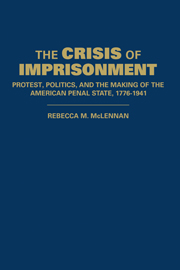Book contents
- Frontmatter
- Contents
- Acknowledgments
- Introduction: The Grounds of Legal Punishment
- 1 Strains of Servitude: Legal Punishment in the Early Republic
- 2 Due Convictions: Contractual Penal Servitude and Its Discontents, 1818–1865
- 3 Commerce upon the Throne: The Business of Imprisonment in Gilded Age America
- 4 Disciplining the State, Civilizing the Market: The Campaign to Abolish Contract Prison Labor
- 5 A Model Servitude: Prison Reform in the Early Progressive Era
- 6 Uses of the State: The Dialectics of Penal Reform in Early Progressive New York
- 7 American Bastille: Sing Sing and the Political Crisis of Imprisonment
- 8 Changing the Subject: The Metamorphosis of Prison Reform in the High Progressive Era
- 9 Laboratory of Social Justice: The New Penologists at Sing Sing, 1915–1917
- 10 Punishment without Labor: Toward the Modern Penal State
- Conclusion: On the Crises of Imprisonment
- Select Bibliography
- Index
3 - Commerce upon the Throne: The Business of Imprisonment in Gilded Age America
Published online by Cambridge University Press: 18 August 2009
- Frontmatter
- Contents
- Acknowledgments
- Introduction: The Grounds of Legal Punishment
- 1 Strains of Servitude: Legal Punishment in the Early Republic
- 2 Due Convictions: Contractual Penal Servitude and Its Discontents, 1818–1865
- 3 Commerce upon the Throne: The Business of Imprisonment in Gilded Age America
- 4 Disciplining the State, Civilizing the Market: The Campaign to Abolish Contract Prison Labor
- 5 A Model Servitude: Prison Reform in the Early Progressive Era
- 6 Uses of the State: The Dialectics of Penal Reform in Early Progressive New York
- 7 American Bastille: Sing Sing and the Political Crisis of Imprisonment
- 8 Changing the Subject: The Metamorphosis of Prison Reform in the High Progressive Era
- 9 Laboratory of Social Justice: The New Penologists at Sing Sing, 1915–1917
- 10 Punishment without Labor: Toward the Modern Penal State
- Conclusion: On the Crises of Imprisonment
- Select Bibliography
- Index
Summary
Business chances
A manufacturer, who has a very favorable contract for prison labor, only a short distance from the city, fine workshops warmed by steam and fitted with engine and machinery, is desirous of getting some staple article to manufacture, or would sub-let part of the labor.
Classified advertisement, New York Times, 1870.In the 1870s, large-scale industrial interests set up shop in the American penal system. As Reconstruction was defeated in state after state in the South, and the great burst of post-bellum social reform in the North fell victim to economic depression and fiscal retrenchment, state and county governments consolidated their prison labor contracts, and conveyed the labor power of entire prison populations to just one or a few enterprises. In the course of the Gilded Age, the administration, discipline, routines, rituals, objectives, and human subjects of legal punishment became subject, in both direct and indirect ways, to the imperatives of profit-making. Those imperatives were given freest – and bloodiest – reign in the infamous convict lease camps of the “redeemed” American South. Taking full possession of their prison laborers, the great majority of whom were former slaves or the sons and daughters of slaves, large-scale private enterprise put prisoners to the dangerous, hard labor of draining malarial swamps, mining and heaving coal, tapping trees for turpentine, and laying mile upon mile of railroad track. By any measure, these convicts lived, toiled, and died under much harsher conditions than did their counterparts to the North and West.
- Type
- Chapter
- Information
- The Crisis of ImprisonmentProtest, Politics, and the Making of the American Penal State, 1776–1941, pp. 87 - 136Publisher: Cambridge University PressPrint publication year: 2008



